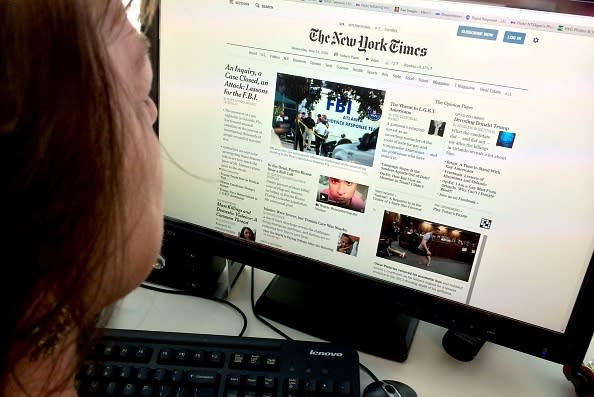News sites have embraced paywalls that alienate readers

The news business has embraced an old business model to stay afloat online: monthly or yearly subscriptions, enforced by “paywalls” that limit non-subscribers to a few or no stories a month.
Such early paywall adopters as the New York Times (NYT) are now touting their subscription successes, inspiring other sites to adopt the strategy. Even Google (GOOG, GOOGL) announced Wednesday that it would manage subscriptions for news sites.
It seems like a sane response to the online advertising slump. But such a move can alienate readers because publishers are asking for a credit card when readers aren’t necessarily ready for such a commitment. And while alternatives exist, they remain confined in closed beta tests.
Subscriptions as an ad antidote
To understand why so many news sites now want a financial relationship with you, consider the shaky state of online advertising.
A frighteningly large chunk of ad revenue goes straight to Google and Facebook (FB), ad fraud wastes billions of dollars, and ad networks can’t stop gangs of crooks from infecting legitimate sites with malicious ads.
And non-malicious ads continue to be too pushy in their presentations, forcing some readers to resort to installing ad blockers on browsers and leading Google to have its Chrome browser block the most annoying ads.
(Yahoo Finance’s parent company Verizon [VZ] has a large online-advertising business.)
Subscriptions can liberate sites from all that. The New York Times, for example, made more money from digital subscriptions than from online ads in the fourth quarter of 2017. Other publications have taken note: Wired, for example, now requires $20 a year to read more than three articles a month.
Google also wants in on the action. The tech giant unveiled Wednesday Subscribe with Google, a Google News Initiative. Subscribe with Google will let readers sign up and pay for subscriptions to news site via their Google accounts. But Google hasn’t said how much revenue publishers will keep.
For the sake of my industry, I hope it tops the 70% Apple (AAPL) allots during an in-app subscription’s first year — and that Subscribe with Google doesn’t flop like One Pass, its 2011 news-subscription venture.
Subscription fatigue is real
Even with Google’s help, how many news subscriptions will most readers want on their bills?
“My gut tells me that, eventually, subscribing to one news source might become a fairly common practice,” wrote Dan Kennedy, a professor at Northeastern University’s School of Journalism, in an email. “The most dedicated news consumers might subscribe to two — their local paper and a national source like the New York Times or the Washington Post.”
And where does that leave sites that interest a reader at a particular time or for a certain topic?
That’s where a Dutch site called Blendle, which launched in the U.S. two years ago, was supposed to step in. Blendle lets users make pocket-change payments — typically 15 cents to 49 cents per story — for ad-free reading at such paywalled sites like the Wall Street Journal. Blendle offers a perfect counter to clickbait: instant refunds for stories that don’t live up to their headlines. You replenish your Blendle wallet with a credit card or a PayPal (PYPL) account.
But if you want to use Blendle right away, you can’t: It’s in a closed beta test. You can, however, “reserve your spot” by submitting your email address.
A boundless beta test
Don’t expect that to change any time soon. “We’re taking our time to perfect the product in a smaller market first, and we’re not quite ready for a more international roll out,” Blendle CEO Alexander Kl?pping wrote in an email Thursday.
Meanwhile, Blendle still faces serious discoverability problems. You can’t copy and paste a paywalled story’s address into Blendle to read it there and instead must search by keywords. Additionally, Blendle’s 25 U.S. partner sites don’t even tell you it exists as a reading option. European publishers can add a Blendle button to paywall dialog boxes, but Blendle hasn’t enabled that option in the U.S. yet.
This frustrates Blendle fans like David Carroll, a media-studies professor at Parsons The New School for Design in New York who has lately been in the news for helping to uncover Cambridge Analytica’s abuse of Facebook user data. “It is remarkable that it is still in beta,” he emailed in February. “That’s kinda crazy.”
Readers need choices
Is there a better alternative to Blendle? On Feb. 22, a site called Scroll launched offering ad-free reading of an unspecified number of stories across multiple U.S. publications for $5 a month. Its backers include two early Blendle investors, the New York Times and German publishing firm Alex Springer, plus Gannett (GCI) and News Corp. (NWS). (Disclosure: I also write for Gannett’s USA Today, but I only learned about Scroll after reading about it on USA Today’s site.)
But what’s Scroll like? Sorry, I can’t tell you. That site too, is in a closed beta, greeting visitors with an invitation to leave their email “to be the first to use Scroll.”
Email Rob at [email protected]; follow him on Twitter at @robpegoraro.
